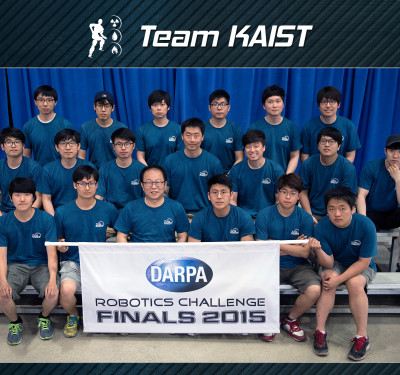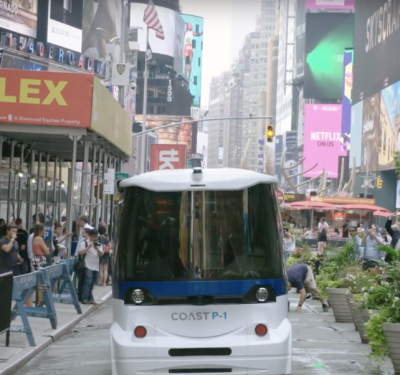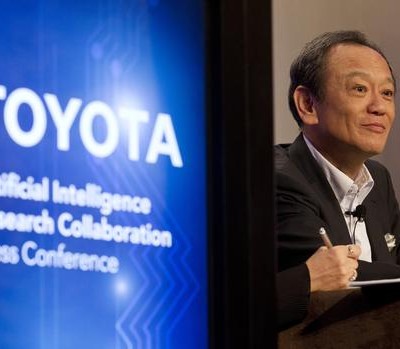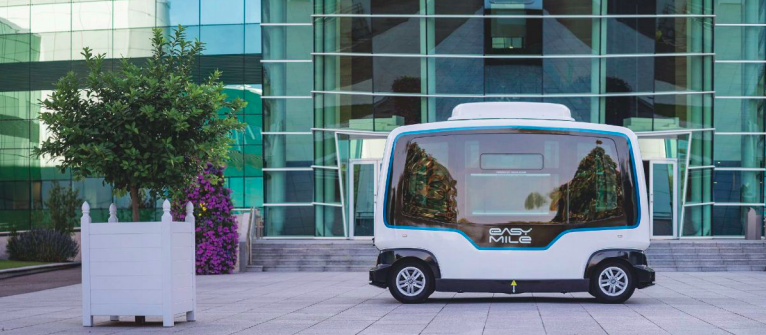
These shuttles, which are designed to ease congestion and improve mobility, are already being tested in a variety of places, including college campuses and city centers.
As we move toward a world where cars drive themselves, autonomous shuttles represent an attractive transportation method that will reduce congestion and make it easier to get around. These vehicles could soon become a common sight on college campuses, in city centers, around shopping plazas and in other places where first- and last-mile mobility can be improved.
Companies like EasyMile, COAST Autonomous, Local Motors and Toyota are already testing these low-speed shuttles in real-world environments to better under- stand how to safely integrate them. The shuttles are operating in busy areas filled with pedestrians and bicyclists. They’re driving pre-defined routes and referencing 3D maps to reliably take passengers where they need to go, whether it’s directly to their final destination or to another form of public transit. Feedback from riders is a critical aspect of each test, as is gaining the public’s trust and increasing its comfort level with the technology.
Deploying these shuttles will reduce congestion and time wasted looking for parking, open up space once needed for large garages, increase safety by eliminating human error, alleviate congestion, reduce car emissions and benefit people with limited mobility. Transportation will simply become more efficient, while “giving living space back to people,” said Pierre Lefevre, chief technology officer and board member for COAST Autonomous. Self-driving shuttles will make their rounds and be available whenever riders need them, 24 hours a day, seven days a week, including for on-demand trips.
Challenges from defining regulations to gaining public acceptance must be overcome before communities can truly reap the benefits autonomous shuttles can provide. But these vehicles are giving people an early look into what life can be like in a driverless world.
“It’s a new mobility option that’s extremely safe,” said Lauren Isaac, director of business initiatives for EasyMile, an autonomous mobility company headquartered in France. “Our customers see driverless vehicles as the future and our shuttles offer an early opportunity to learn what it takes to introduce the technology and determine the potential.”
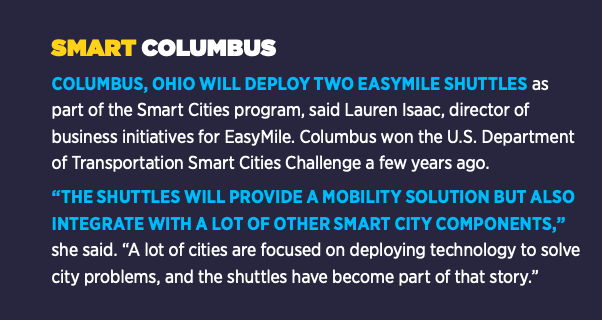
TESTING THE TECHNOLOGY
EASYMILE
EasyMile has had a busy testing schedule, with more than 250 projects deployed in 27 different countries, Isaac said.
The Utah Department of Transportation (UDOT), in partnership with the Utah Transit Authority (UTA), is deploying the shuttle in different communities through- out that state during a year-long pilot pro- gram that kicked off in April.
The team at UDOT wants to give community members the opportunity to experience autonomous shuttles, as well as sense how they see the technology fitting into their everyday lives, said Chris Siavrakas, project manager for UDOT’s Intelligent Transportation Systems. UTA is interested in determining how the shuttles will integrate with other public transit options, such as commuter rail.
The shuttle has driven along routes in a variety of venues located near public transportation, including a shopping plaza, an office complex, a hospital and a university. UDOT has conducted surveys to learn what community members think about the shuttles, and has brought in user groups. While the team is still processing the feedback, Siavrakas said most passengers seem to feel safe on the shuttles and are accepting of the technology.
To ensure riders get where they need to go, the shuttle features a variety of sensors that allow for precise localization and navigation, including LiDAR, radar, GPS, and Network Real Time Kinematic (NRTK) Positioning combined with odometry and an inertial measurement unit (IMU). The technology allows the shuttle to travel down a pre-determined path and safely avoid any obstacles along the way.
“It’s pretty precise,” Siavrakas said. “After two or three weeks at a venue you’ll start to see an actual track from the shuttle. It’s also important that it pulls right up to the curb when it stops for wheelchair accessibility. It has to know exactly where to go if there’s no operator on board.”
While traveling without a safety operator is the goal, the operator must remain for now, as required by law, Siavrakas said. This person interacts with passengers, answers their questions and can take over when needed, like when a large FedEX truck parks in front of the shuttle’s path. The technology doesn’t have the maturity to deviate from its path and navigate around such large objects yet, but Siavrakas hopes that level of sophistication will be integrated into the next generation.
EasyMile recently completed a test without a safety operator on a corporate campus in France—the first deployment of its kind, Isaac said. The operator was eliminated in a staged approach so riders were prepared and comfortable during the trips.
COAST AUTONOMOUS
COAST Autonomous has conducted more than 60 trials in seven countries, and its shuttle was the first autonomous vehicle to operate in Manhattan, driving in Times Square along Broadway last year, President and Board Member Adrian Sussmann said. The team recently ran a successful week-
long test on the University of South Florida campus, where the Coast P-1 shuttle drove students, faculty and visitors along the walkway between the library and recreation center.
The shuttle transported more than 500 riders during the test, which was led by the university’s Center for Urban Transportation Research (CUTR) and sponsored by the National Center for Transit Research (NCTR) and the Florida Department of Transportation (FDOT), center Program Director Pei-Sung Lin said.
The research team wanted to learn how people on campus felt about autonomous shuttles and to hear their concerns and suggestions, said Nikhil Menon, a post-doctoral research associate involved with the project. They’re still analyzing the data, which includes general insights from riders on adopting the technology.
Low-speed autonomous shuttles can bring many benefits to a college campus, Lin said, including eliminating the headaches that come with searching for parking spots. Shuttles can pick students and faculty up from a remote parking location, then take them from class to class throughout the day, saving time and reducing car emissions.
“A lot of the students loved riding it,” Sussmann said. “This is a beautiful campus with a car park right in the middle. It’s probably the most valuable real estate on the campus, and these vehicles make it possible to use that space differently.”
To safely complete such trips, the COAST Autonomous shuttle features three different types of LiDAR for localization and object detection, cameras and a robotics system that controls every area of the vehicle, from monitoring tire pressure to steering position to opening and closing doors, Lefevre said. Artificial intelligence manages the vehicle’s behavior, including obstacle avoidance. The shuttle doesn’t use GPS and instead has a solution for both in- door and outdoor mapping that generates an accurate 3D point cloud.
“We put the solution on top of the car, drive it at normal speed and then post process. From that we get a very accurate 3D point cloud of the roads,” Lefevre said. “We don’t need the map to be 100 percent accurate. We can remove half the buildings and the map would still be accurate because it uses map matching and SLAM (Simultaneous Localization And Mapping) to relocate. We can drive in Manhattan, which is difficult with GPS, and we can drive inside a building and under a tree canopy without any trouble and without an RTK station.”
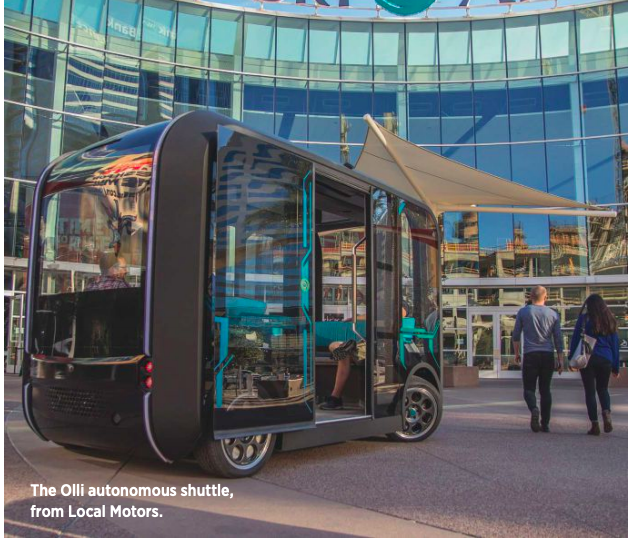
LOCAL MOTORS
Local Motors recently began testing its autonomous shuttle, Olli, at GoMentum Station, a closed-course testing facility for connected and automated vehicles in California’s Contra Costa County. The team also has deployments in Amsterdam, National Harbor, the Curiosity Lab at Peachtree Corners in Atlanta, the University of Buffalo and the Goodyear campus in Akron, Ohio, to name a few. So far, riders are happy with their experience on the electric, 3D-printed, environmentally friendly shuttle, Local Motors President Vikrant Aggarwal said.
The Peachtree Corners pilot began in October at the smart city living laboratory, he added. The city won Local Motors’ Atlanta Olli Fleet Challenge, competing against other municipalities, camp
and districts that proposed short-term uses for Olli. Two Olli shuttles now trans- port Peachtree Corners residents and workers through a 1.5-mile autonomous vehicle test track that includes shops and office buildings.
“We’re looking at working with cities to figure out how Olli can become part of a broader transportation eco system,” Aggarwal said. “So, going from a bike in Amsterdam to a shuttle to a public bus back to a shuttle. I think that’s key. The other area is ride hailing. We know people don’t want fixed routes. They want more on-demand options. Our whole focus is to improve the lifestyle of the consumer and to give more control to the user.”
THE OLYMPICS
Toyota’s e-Pallett, featuring Level 4 autonomy, will shuttle athletes, workers, and visitors during the 2020 Olympics in Tokyo, said Nathan Kokes, mobility & advanced technology communications manager. The shuttle can drive completely on its own and uses a variety of sensors, including LiDAR, radar and sonar, to help ensure it maintains a safe distance from other vehicles and pedestrians while it traverses its set path. All 20 shuttles working the games will be geofenced inside the Olympic Village and nearby surrounding areas, and all will have a safety driver.
The shuttle will leverage 3D, high-definition mapping technology, Kokes said, so it’s not only relying on real-time data of objects in and surrounding its pathway, it’s also using embedded information that already knows the route and all the fixed objects along it. The vehicles will move at about 11 miles per hour, safely transporting Olympians and staff where they need to go.
“This is a testing ground for Toyota to see a vehicle like this in operation at lower speeds in a congested environment, with various scenarios that are yet to be defined,” Kokes said. “The world will be focused on the Olympics games, making this a great opportunity to really showcase what advanced technology could be like in the future.”
A NEED FOR HUMAN INTERACTION
Robots can’t interact the way people do. They’re not able to make eye contact or draw inferences based on a human’s actions, which is something that’s lost with autonomous shuttles. Srikanth Saripalli, an associate professor at Texas A&M University, learned this during a recent trial. He has been working on developing autonomous shuttles for years, and deployed one of the vehicles, which features an autonomous driving system from AutonomouStuff, in downtown Bryan, Texas. The shuttle was deployed in a half-mile loop for about two months, with Saripalli and his team working very closely with city officials during the project. The shuttle had two safety drivers, and Saripalli saw that they not only needed to take over from time to time, they also interacted with riders quite a bit.
Passengers might ask drivers to have the shuttle drop them off at a certain place or try to hail a ride by waving their hand. It became clear to Saripalli that even when they reach a point where a safety driver isn’t required, there will still need to be some level of human interaction. That’s why Saripalli partnered with Designated Driver, a company that offers a tele-operations service for autonomous vehicles. He is finishing up installing the software into the shuttle, which will be deployed for a second trial in Bryan. This time, the project will last for six months to a year and will cover a 1.5-mile loop.
The shuttle should be running again by the end of December or early in 2020. A safety driver and navigator will still be part of the tests, but after two to three months the team will re-evaluate, and, if everyone agrees, remove the safety driver so they can really see how well the teleoperations system works. “Robots are really good at automation, but robots are very bad at interaction,” Saripalli said. “If you want to go on a freeway you have fixed lanes and you’re going from point A to point B. But if you’re driving in a neighborhood, you have to stop at four-way stop signs and you have to pick up and drop people off. There’s a lot of interaction with passengers and other drivers. We’re a long way from figuring out how to do that autonomously.”
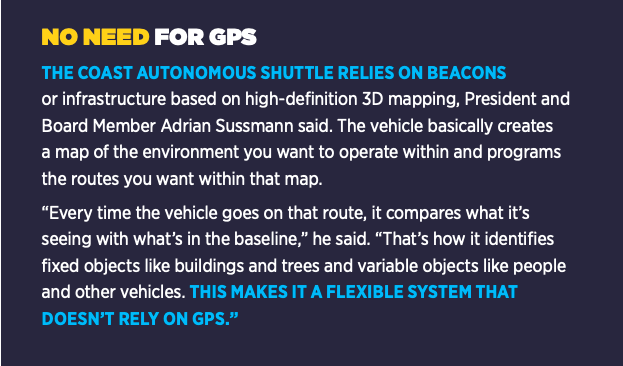
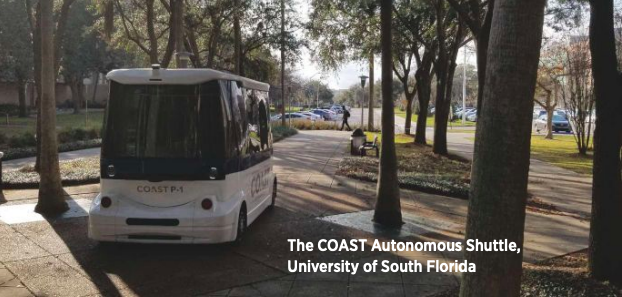
COMMUNICATING WITH INFRASTRUCTURE
Amir Khajepour, a professor at the University of Waterloo, in Canada, is developing an autonomous shuttle that can operate in any weather or light conditions. His team is determining how to combine different sensors to develop a safe, reliable shuttle that can handle wind, heavy rain, snow, fog and hail. He also plans to mount stationary sensors on the infrastructure, including stop signs, and at busy intersections and traffic lights, to give the vehicles a better view of what’s happening around them. The extra sensors can help shuttles predict where humans are going, Khajepour said. If a pedestrian suddenly jumps out into an intersection, for example, the sensors provide the vehicle a view of the intersection and the information needed to determine how to maneuver to avoid hitting that pedestrian.
“As humans we can predict many things that a machine can’t,” Khajepour said. “But by giving a big view of the intersection to the car, it can make better decisions and eliminate some of those edge cases that the car may not be able to decide on, creating the level of safety required for these situations.”
UDOT and UTA also are working on infrastructure communication, Siavrakas said, including how the shuttle will react if it’s told to stop at a specific point.
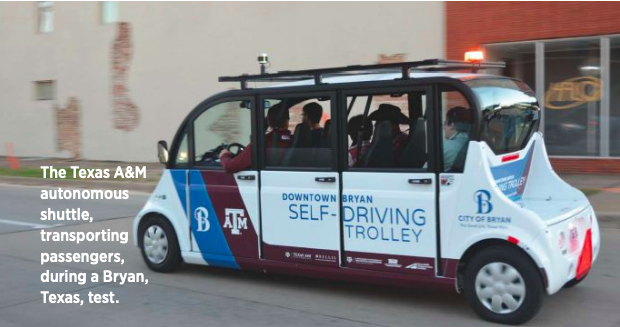
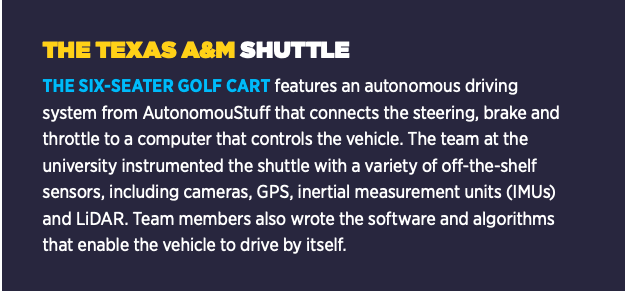 THE CHALLENGES
THE CHALLENGES
While autonomous shuttles seem to be on track for adoption in the near future, there are still challenges that must be overcome before we can get there. One of the biggest is public perception, Aggarwal said. Consumers must feel safe riding in the shuttles, which is why validating the technology through tests that involve consumers is so important. Creating a great experience is also critical, Lefevre said. That means developing algorithms that offer a smooth, safe ride at optimal speeds without sudden stops that jostle riders. Lack of regulations is another barrier to mass adoption, Isaac said. These shuttles don’t comply with Federal Motor Vehicle Safety Standards, as they don’t have traditional rearview mirrors or steering wheels. That means companies like EasyMile must get exemptions to operate in the U.S. Rules vary state by state, with some very welcoming to autonomous vehicles (AVs) and others not as much. It takes a lot of collaboration with state, local and federal government to deploy these shuttles, but that will get easier once there’s a regulatory framework in place to help guide the process. And then of course there are the pedestrians, bicyclists and skateboarders. Autonomous shuttles operate in mixed environments and must have algorithms that enable them to react appropriately to random human behaviors. “It’s a completely different environment than operating on a street with other traffic. That’s the specific challenge,” Sussmann said. “We’ve managed to finetune the software and the hardware so the vehicle doesn’t stop, it actually keeps moving forward and makes its way with the crowd at walking speed, or if it can it will overtake safely. There’s a misconception that it’s easy to operate in a low-speed environment but that’s not the case at all.”
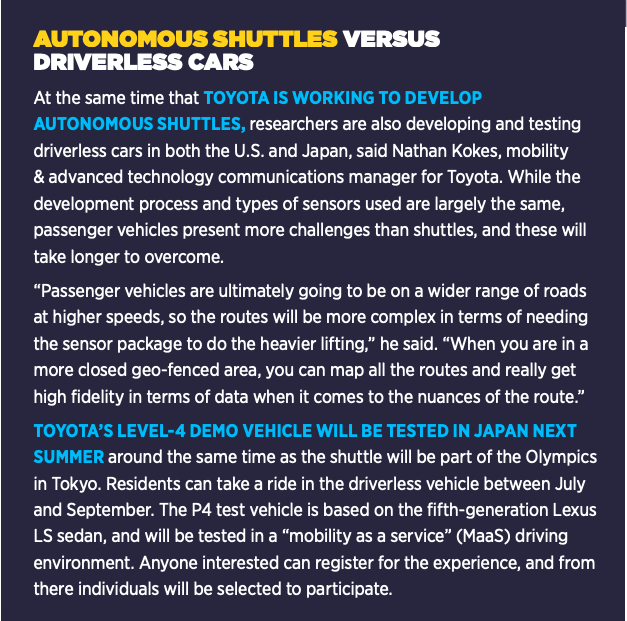
THE FUTURE
As companies continue to advance the technology, more trials will be conducted across the globe to introduce the public to self-driving shuttles, Menon said. Consumer insights will play a critical role in how and when these technologies are integrated on a large scale. More fleets will appear, Isaac said, with shuttles traveling around college campuses, city centers, shopping plazas, hospitals, resorts and theme parks, giving the public continual access to a true first- and lastmile mobility solution. As prices come down and the technology is proven, more cities and business owners that can benefit from autonomous shuttles will start to explore and eventually invest in them. They’ll become a reliable mobility option long before driverless cars are a mainstay on our roadways. “This will be a big change in the future,” Lin said. “People see a shuttle or a car driving on their own and they are amazed by it, but they’re not sure if the car is 100 percent safe if something happens. That’s the psychological challenge right now. And if something happens, what is plan B? Are there redundancies to ensure safety of operation? From our demo, we see a majority of people feel safe riding in autonomous shuttles, and a lot of people who were hesitant at first change their minds after taking a ride.”


